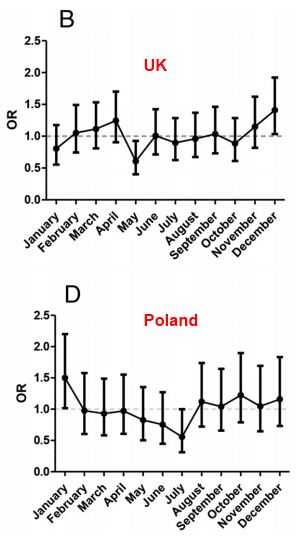Autoimmune Addison's Disease – increased risk if born in Dec or Jan
Impact of Month of Birth on the Risk of Development of Autoimmune Addison's Disease.
J Clin Endocrinol Metab. 2016 Nov;101(11):4214-4218
Pazderska A1, Fichna M1, Mitchell AL1, Napier CM1, Gan E1, Ruchała M1, Santibanez-Koref M1, Pearce SH1.
1Institute of Genetic Medicine (A.P., A.L.M., C.M.N., E.G., M..S-K., S.H.P.), Newcastle University, Newcastle upon Tyne, NE1 3BZ United Kingdom; Institute of Human Genetics (M.F.), Polish Academy of Sciences, 60-479, Poznan, Poland; and Department of Endocrinology, Metabolism and Internal Medicine (M.F., M.R.), Poznan University of Medical Sciences, 60-355 Poznan, Poland.
📄 Download the PDF from VitaminDWiki

CONTEXT:
The pathogenesis of autoimmune Addison's disease (AAD) is thought to be due to interplay of genetic, immune, and environmental factors. A month-of-birth effect, with increased risk for those born in autumn/winter months, has been described in autoimmune conditions such as type 1 diabetes and autoimmune thyroid disease.
OBJECTIVE:
Month-of-birth effect was investigated in 2 independent cohorts of AAD subjects.
DESIGN, SETTING, AND PATIENTS:
The monthly distribution of birth in AAD patients was compared with that of the general population using the cosinor test. A total of 415 AAD subjects from the United Kingdom cohort were compared with 8 180 180 United Kingdom births, and 231 AAD subjects from the Polish cohort were compared with 2 421 384 Polish births.
MAIN OUTCOME MEASURES:
Association between month of birth and the susceptibility to AAD.
RESULTS:
In the entire cohort of AAD subjects, month-of-birth distribution analysis showed significant periodicity with peak of births in December and trough in May (P = .028). Analysis of the odds ratio distribution based on month of birth in 2 cohorts of patients with AAD versus the general population revealed a December peak and May trough, and January peak and July trough, in the United Kingdom and Polish cohorts, respectively.
CONCLUSION:
For the first time, we demonstrate that month of birth exerts an effect on the risk of developing AAD, with excess risk in individuals born in winter months and a protective effect when born in the summer. Exposure to seasonal viral infections in the perinatal period, coupled with vitamin D deficiency, could lead to dysregulation of innate immunity affecting the risk of developing AAD.
VitaminDWiki – Season of Birth category contains:
{include}
See also VitaminDWiki
Autoimmune category listing has items along with related searches
